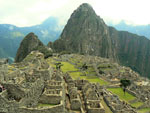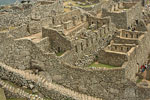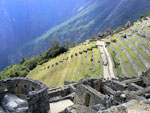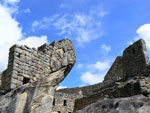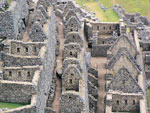Machu Picchu Inca City
"The Holy City of the Incas" - "The Lost City""Natural and Cultural World Heritage Site" by UNESCO
The New 7 Wonder of the World
About Machu Picchu Inca Citadel
It is a mystical place, a monument to divinity, where people can feel that they are a creation of God.
The high sense of spirituality that inhabits this place seems to transport its visitors to a place where everything "in an unimaginable way" is possible.
It is a place where strange forces of nature allow the individuals to reach an incomparable cosmic state, a state that can only be experimented in Machu Picchu.
It is one of the most popular archaeological sites of the world, and therefore, the most visited attraction in Peru.
The Citadel of Machu Picchu (Quechua language "Old Mountain") is known throughout the world for its amazing ruins and its unusual location on a high mountain overlooking the mighty currents of the Urubamba river.
Even today nobody has been able to solve the mystery how the builders and designers managed to transport the huge blocks of limestone to the top of the mountain required for the construction of the city.
Probably built during the 15th century in a very difficult location, it is the greatest achievement of the Incas architects due to the intelligence and dare demonstrated by their design. It has an extent of 13 sq/km and its main functions were military and religious. It used to be surrounded by an outer wall with a height of 6.00 m. and a width of 1.80 m. and it is estimated that it was inhabited by 10,000 people. Built of limestone (the outer and inner walls), wood (doors and frames), and ceilings made of straw.
Machu Picchu is located 2,300 meters above sea level (7,546 ft.), at 112 km. (70 miles) from Cuzco, in the Urubamba valley in the lowest part of the Sacred Valley of the Incas in a area of direct access to the upper jungle. Without doubt, Machu Picchu was part of a very big complex of fortresses which defended the Andean lands in Sacred valley of any assault from native people out of the jungle.
Having Huayna Picchu as a background they divided Machu Picchu in four sectors. Northwest is located the area that was probably used for the main religious purposes, that includes a Plaza named by Hiram Bingham as "Sacred Plaza", also the temple of the "Three Windows", "The Sacred Temple", the "Priests Mansion", and the "Intihuatana" that is a large block of limestone used during Inca ceremonies.
The "Intihuatana" (Quechua "place where the sun is bonded") is a solar observatory that allowed the Incas to keep track of the seasons of the year and the flow of time based on the shadows caused by the sun over the stone.
The largest residences are located on the northeast of the complex. The most luxurious residences and also a watch tower are located on the southwest of the complex and therefore it is assumed that this part of the Citadel was probably the heart of all the urban activities.
To the southeast of the complex are located the smallest and most humble of the buildings built around very narrow streets, close to numerous terraces constructed for agricultural purposes as denoted by the existence of a very complex aqueduct system in this area. In the lowest part of the terraces is a cemetery, where during a search were discovered 135 skeletons and 109 of them were identified as females. This fact has allowed historians and archeologists to believe that Machu Picchu's inhabitants were mostly females that could have been the chosen ones of the Inca, fleeing from Cuzco when it was overrun by the Conquerors of Spain and seeking refuge in Machu Picchu that, by the way, was never discovered by the Spaniards.
Machu Picchu was introduced to the scientific world by Hiram Bingham, who was led to the site by the folk that lived in the area. He reached it on July 24th,1911. Bingham, an American Anthropologist from Yale University, was the one that began the Archaeological studies of the area, and it was him who gave the city the title of the "Lost City of the Incas" that was also the name he used for his book on the subject.
Since 1981 it has been declared Historic Sanctuary of Machu Picchu as well as Natural and Cultural World Heritage Site by UNESCO because of its archaeological importance as well as its unique flora such as the orchids that you may find aplenty.
The Monumental Mausoleum is a construction made of limestone with carved walls which interiors were used for religious rituals as well as sacrifices.
Inside the Citadel can be found a sector used as a jail where torment and punishment were given to the prisoners that were kept inside small niches carved in the stone.
The residential area includes a sector used by the nobles of the Citadel. It can be distinguished by the fact that it is constructed over a slope and the constructions are neatly separated from each other. Those residences were used by the "Amautas" (Quechua language " wise people") and by the "Ñustas" (Quechua language "princess") and their rooms had trapezoidal shape.
During the time of the Incas, Machu Picchu was reached following a mountain trail at 3281 ft. over the left bank of Urubamba river. This trail went through the following locations where interesting ruins in typical Inca style can still be found and visited, if you decide to follow the Inca Trail: Patallacta, Huallabamba, Runku Rakay, Sayacmarca, Phuyu Pata Marca and Huiñay Huayna.
From Machu Picchu you can take a trail shaped to the resemblance of a horse shoe that will take you through high mountains and lead you to the breathtaking summit of the Huayna Picchu that is located to the Northeast of the Citadel. From there you will see the most beautiful view of the whole Citadel of Machu Picchu and you may experience being close to the Gods that took the Incas through their History. During the trip you will see natural caves, sculpted caverns, and terraces with volleys of very steep stairwells that were shaped out of the natural rock formations by the Incas. Also, at the top of the Huayna Picchu you will see the Andenes (structures in the shape of terraces that were used for agricultural purposes and semi circular walls) and the Moon Temple.
Controversy with Yale University
In 1912 and 1914–15, Bingham excavated treasures from Machu Picchu—ceramic vessels, silver statues, jewelry and human bones—and took them from Peru to Yale University in the United States for further study, supposedly for a period of 18 months. Yale has retained the artifacts until now, under the argument that Peru did not have the infrastructure or proper conditions to take care of the pieces.
Eliane Karp, an anthropologist who is married to the former Peruvian President Alejandro Toledo, accused Yale of profiting from Peru's cultural heritage by claiming title to thousands of pieces removed by Bingham. Many have been on display at Yale's Peabody Museum since. Yale returned some of the artifacts to Peru, but the university kept the remainder, claiming its position was supported by federal case law involving Peruvian antiquities.
On 19 September 2007, the Courant reported that Peru and Yale had reached an agreement regarding the requested return of the artifacts. The agreement includes sponsorship of a joint traveling exhibition and construction of a new museum and research center in Cusco about which Yale will advise Peruvian officials. Yale acknowledges Peru's title to all the excavated objects from Machu Picchu, but Yale will share rights with Peru in the research collection, part of which will remain at Yale as an object of continuing study.
On 19 June 2008, National Geographic Society's vice-president Terry Garcia was quoted by daily La República. "We were part of this agreement. National Geographic was there, we know what was said, the objects were lent and should be returned."
On June 2010, one year before the centenary of encounter of Machu Picchu with Occidental World, the Dr. Alan Garcia, President of Peru, severely demanded to the Yale University to give back everything.
On 21 November 2010, Yale University agreed in principle to the return of the controversial artifacts to their original home in Peru.
From June 5th 2011, all objects and archaeological pieces given back by the Yale University they will be exhibited in the Casa Concha in the city of Cuzco.
If you enjoy good books and poems and if your travel plans include Machu Picchu we may suggest to read the poem "Heights of Machu Picchu" (Alturas de Machu Picchu) written by the famous Chilean writer and Nobel Prize winner Pablo Neruda.
"I felt infinitely small in the center of that navel of rocks of a deserted world, proud, towering high, to which I somehow belonged. I felt that my own hands labored there at some remote point in time, dining furrows, polishing rocks": Pablo Neruda, Memories.
"For many people, the words Machu Picchu conjure up an image of a lost Inca city, swathed in the green creepers of an encroaching jungle, hidden behind the years, waiting to be discovered by intrepid explorers armed with machetes and attended by armies of porters. It was like this, there's no doubt - all you have to do is look at the photographs of the Hiram Bingham expedition to be reminded of Indiana Jones from the film "Raiders of the Lost Ark" - but today, sadly, some of the mystique has gone. You can now make a day trip to the site by train or helicopter, and if you want to spend the night near the ruins there is a reasonable hotels close to the old stones" R. Danbbury
The minimum recommended time to visit and trip to Machu Picchu is one day (from Cuzco) or 4 days if you make the Inca Trail trek.
Machu Picchu by National Geographic
 MACHU PICCHU PHOTO GALLERY
MACHU PICCHU PHOTO GALLERY
- Machu Picchu
- Machu Picchu between heaven
and earth - Inca Trail
- Hiram Bingham Deluxe Train
- Orchids in Machu Picchu # 1
- Orchids in Machu Picchu # 2
- Orchids in Machu Picchu # 3
- Orchids in Machu Picchu # 4
 MACHU PICCHU TRAVEL GUIDE - SEE ALSO:
MACHU PICCHU TRAVEL GUIDE - SEE ALSO:
- Machu Picchu Travel Guide
- Historic Sanctuary of Machu Picchu
- Machu Picchu Inca City
- Machu Picchu new 7 Wonders
- Inca Trail to Machu Picchu
